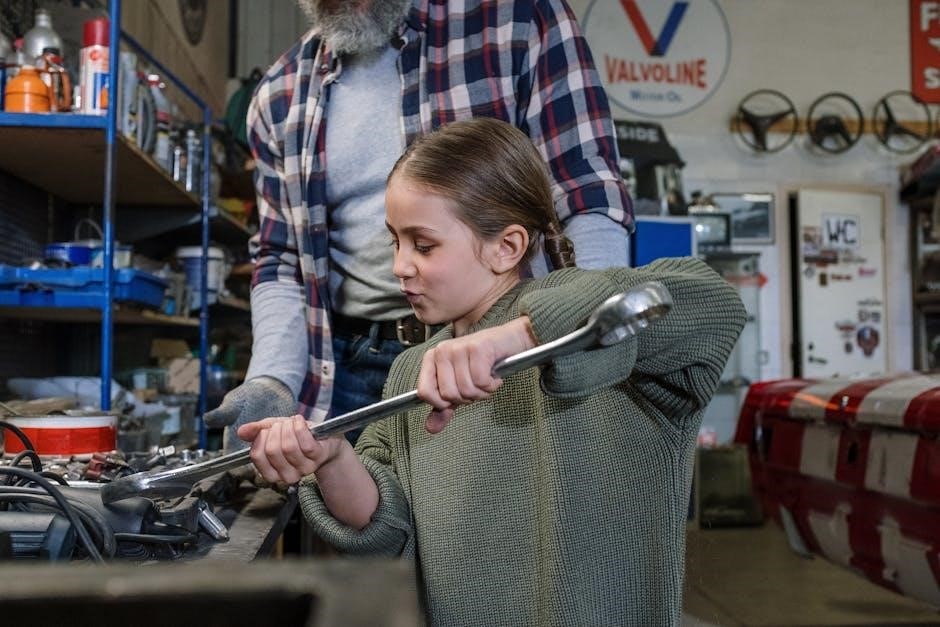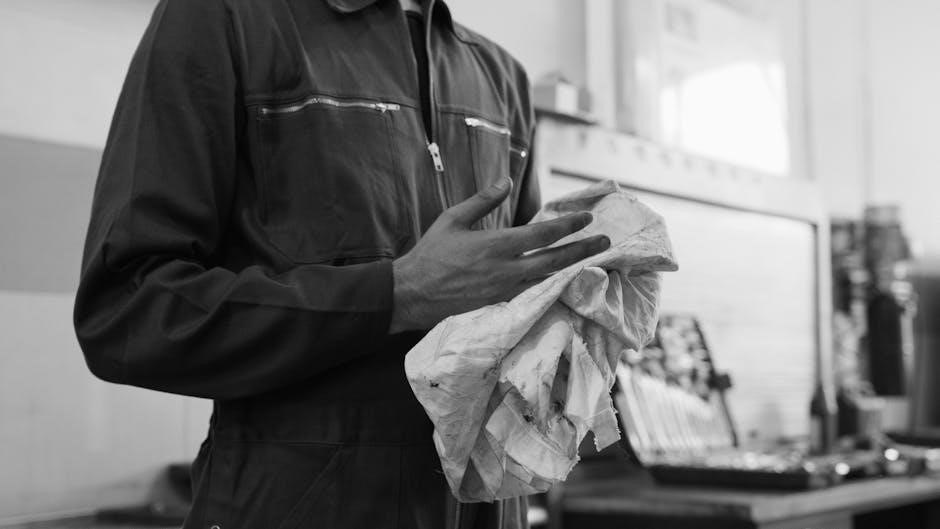The Cessna 182S Maintenance Manual is a comprehensive guide for owners and mechanics, detailing essential procedures for upkeep, inspections, and repairs. It covers pre-flight checks, routine tasks, and troubleshooting common issues, ensuring optimal performance and safety. Regular adherence to this manual helps maintain the aircraft’s reliability and extends its service life.

Pre-Flight Inspections and Checks
Pre-flight inspections for the Cessna 182S involve checking control surfaces, tires, fuel levels, and landing gear. Use the POH checklist to ensure all systems are functioning properly.
General Inspection Procedures
General inspections for the Cessna 182S begin with a visual examination of the aircraft’s exterior and interior. Check for damage, wear, or corrosion on surfaces, wings, and control panels. Ensure all fasteners and rivets are secure. Inspect tires for proper inflation and signs of wear. Examine fuel tanks, lines, and caps for leaks or damage. The cockpit should be checked for instrument functionality, ensuring all gauges and avionics are operating correctly. Pay attention to the control yoke, rudder pedals, and throttle for smooth operation. Refer to the POH for specific items to inspect during pre-flight checks.
Retractable Landing Gear Maintenance
Regular maintenance of the Cessna 182S retractable landing gear ensures smooth operation and safety. Inspect the gear system for hydraulic leaks, wear, or damage. Check the hydraulic fluid level and top it off as needed. Lubricate moving parts annually. Test the gear cycle to ensure proper extension and retraction. Inspect electrical components, such as solenoids and relays, for wear or corrosion. Verify microswitch functionality to prevent gear malfunctions. Refer to the maintenance manual for detailed procedures and intervals. Always address issues promptly to avoid system failure during flight operations.

Routine Maintenance Tasks
Routine maintenance tasks for the Cessna 182S include regular inspections, lubrication of moving parts, fluid checks, and system evaluations to ensure optimal performance and safety.
Oil and Filter Change Procedures
The Cessna 182S maintenance manual outlines specific procedures for oil and filter changes to ensure engine longevity. Draining the old oil and replacing the filter with a new one is critical. Use the correct tools to avoid spills, and dispose of used oil responsibly. Refill the engine with the recommended type and amount of oil, as specified in the manual. Regular oil changes help maintain optimal engine performance and prevent overheating. Always refer to the manual for torque specifications and filter part numbers to ensure compliance with manufacturer guidelines.
Spark Plug Replacement and Inspection
Spark plug replacement and inspection are vital for maintaining the Cessna 182S engine’s performance. Use a torque wrench to remove plugs, inspecting for fouling or wear. Clean or replace plugs as needed, ensuring proper gap specifications. Refer to the manual for recommended part numbers and torque values. Always install new plugs securely to avoid damage. Regular inspection helps prevent engine misfires and ensures optimal combustion efficiency. Follow the manual’s guidelines for interval replacements to maintain peak engine operation and reduce the risk of premature wear on other components.
Air Filter Cleaning and Replacement
Regular air filter cleaning and replacement are crucial for maintaining the Cessna 182S engine’s performance and fuel efficiency. Inspect the air filter during pre-flight checks for dirt or damage. Clean the filter with compressed air or replace it if damaged. Use only approved materials and follow the manual’s guidelines for proper installation. Replace the air filter at intervals specified in the maintenance manual to ensure optimal airflow and prevent engine damage. Proper maintenance of the air filter helps maintain consistent engine performance and prevents unnecessary wear on other components.

Cylinder Head Temperature Management
Proper cylinder head temperature management is vital for engine performance and longevity. Monitor temperatures during flight to prevent overheating, ensuring optimal operation and minimizing wear on components.
Monitoring Cylinder Head Temperatures
Monitoring cylinder head temperatures (CHT) is critical for maintaining engine health. The Cessna 182S maintenance manual recommends keeping CHTs below 435°F (224°C) during high-performance cruise and under 400°F (205°C) for economy settings. Use the EGT/CHT gauge to track temperatures in real-time. Excessive heat can lead to premature wear or damage. Adjust power settings, cowl flaps, and airspeed to maintain optimal temperatures. Regular monitoring ensures efficient engine operation and prevents overheating issues during flight. Proper management extends engine life and reduces the risk of costly repairs.
Cooling System Maintenance and Strategies
Regular cooling system maintenance is vital to prevent overheating and ensure reliable engine performance. Inspect coolant hoses, connections, and the radiator for leaks or damage. Clean the oil cooler and ensure proper airflow through the cowling. Use a mixture of 50% water and 50% glycol coolant to maintain optimal efficiency. During flight, monitor temperature gauges and adjust cowl flaps as needed to regulate engine temperature. Proper cooling system upkeep prevents premature wear and enhances overall aircraft performance, ensuring safe and efficient operation under various flight conditions.
Troubleshooting Common Issues
Troubleshooting common issues in the Cessna 182S involves identifying symptoms, inspecting components, and addressing problems like fuel leaks or retract system malfunctions. Regular checks prevent major issues, ensuring safe flight operations.
Identifying and Addressing Fuel Leaks
Fuel leaks in the Cessna 182S can be identified by visually inspecting fuel lines, tanks, and connections for stains, drips, or odors. Regular monitoring of fuel system components is crucial to prevent leaks. If a leak is detected, tighten connections or replace damaged seals immediately. Addressing leaks promptly avoids potential engine performance issues or safety risks. Always consult the maintenance manual for specific procedures and ensure repairs are performed by a qualified mechanic if uncertainty arises.
Diagnosing Retract System Malfunctions
Retract system malfunctions in the Cessna 182S can manifest as slow or incomplete gear retraction. Inspect hydraulic lines and actuators for leaks or damage. Check electrical connections and switches for proper function. Ensure the gear selector is moving smoothly and the indicator lights are functioning. If issues persist, consult the maintenance manual for specific troubleshooting steps. Addressing these problems promptly is essential to maintain safe and reliable operation of the landing gear system. Regular maintenance and inspections can help prevent malfunctions and ensure the system operates efficiently.

Weight and Balance Management
Proper weight and balance calculations are critical for safe flight operations. Ensure the aircraft’s weight complies with specified limits and adjust cargo or passengers as needed.
Pre-Flight Weight Calculations
Accurate pre-flight weight calculations are essential for ensuring safe and efficient flight operations. Begin by gathering the aircraft’s empty weight, fuel load, and passenger/cargo weights. Use the aircraft’s weight and balance checklist to verify all components. Compare the total calculated weight against the maximum allowable weight specified in the Pilot’s Operating Handbook (POH). Ensure proper load distribution to maintain the center of gravity (CG) within acceptable limits. If unsure, consult an aviation mechanic or trusted resource to verify calculations. Proper weight management enhances aircraft performance, safety, and compliance with regulatory standards.
Managing Modifications and Upgrades
Managing modifications and upgrades for the Cessna 182S requires careful planning and compliance with FAA regulations. Always consult the maintenance manual and seek approval from a certified aviation mechanic or inspector. Modifications, such as engine upgrades or avionics installations, must adhere to specific guidelines to ensure airworthiness. Document all changes meticulously, as improper upgrades can affect performance and safety. Regular inspections and adherence to maintenance schedules are crucial to maintain the aircraft’s integrity; Properly managed upgrades enhance functionality and value while ensuring compliance with safety standards.
The Cessna 182S Maintenance Manual serves as a vital guide for ensuring the aircraft’s safety, reliability, and performance. By following its detailed procedures, owners and mechanics can perform essential inspections, routine maintenance, and troubleshooting effectively. Proper adherence to the manual’s guidelines helps maintain the aircraft’s airworthiness and extends its service life. Regular updates and compliance with regulatory standards are crucial for optimal functionality. Whether addressing pre-flight checks, cylinder head temperature management, or weight and balance calculations, this manual provides a comprehensive roadmap for maintaining the Cessna 182S. Adhering to its recommendations ensures a safe and efficient flying experience.
